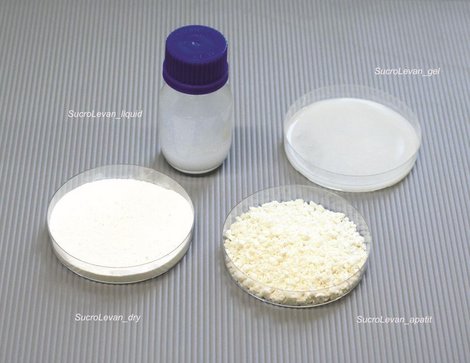Learning from the little ones

International breakthrough: Biotechnologists from Saxony-Anhalt revolutionise the production of the sugar polymer Levan for cosmetics
A lot has been published about Levan in the scientific literature, explains Dr. Norbert Volk. Indeed, the biopolymer is considered to have great potential for use in drug production, as a prebiotic additive for food, and in the cosmetics industry.
He tells us that he actually came across the natural product by chance. As a scientist in the field of pharmaceutical biotechnology at Martin Luther University Halle-Wittenberg, he supervises students studying for an international master's course. "For our practical laboratory work, we were seeking an organism that could produce proteins and then secrete them," he recalls, looking back to the events of more than three years ago. The students and scientists, who specialise in making natural biological processes usable for industrial production, succeeded in finding micro-organisms that produce Levan.
A gap in the market for Levan
This exopolysaccharide helps the tiny micro-organisms attach themselves to surfaces, such as to stones in rivers and streams. It provides protection against drying out, balances out fluctuations in temperatures, and serves as a nutrient reserve. It is these characteristics that make Levan interesting for skin creams in the cosmetics sector, for instance. "It conveys moisture, transports active ingredients and adheres well," explains Dr. Eng. Norbert Volk, which is why the team in Halle believe the natural product to have great potential.
Yet Levan is pretty much unavailable on the market and it’s also expensive. Developing a low-cost production process would therefore be worthwhile. The initial position was good, because the researchers had already worked out how the tiny organisms produce Levan. All they had to do was to imitate them.
Breakthrough: working like the micro-organisms
According to Dr. Volk, three or four working groups are working simultaneously on the production of Levan worldwide. The fact that his project achieved the breakthrough, however, has been down to good luck and the right idea in the partnership with the right partners and the German Federal Ministry of Education and Research, which has been funding the joint project with four participants for two years. "Our product is the SucroLevan combined with a possible application,” explains Norbert Volk. The cosmetics manufacturer artefactum GmbH is a practical partner in the research network. The Society for the Promotion of Medical, Bio- and Environmental Technology (GMBU e.V.), with teams in Halle, Jena and Dresden, as well as Innovent e.V. Jena, are also part of the group. The company BioEconomyCluster Management GmbH from Halle/Saale is responsible for the economic consulting.
The biotechnologists at the university had spent around a year working on Levan synthesis when they formed the network and received the funding. Their strategy: to produce the enzyme that the micro-organisms use to produce Levan.
In the natural world, the Levan structure varies according to the environmental conditions. A long-chain, high-molecular Levan has different properties to a low-molecular Levan, for instance. It is the latter variant which is of interest for the production of cosmetics. High-molecular polymers also have a wide field of application, however.
The project partners optimised the production of the enzyme and then the production process for Levan itself. Innovent was responsible for the analytics, GMBU for the adaptation of the technology to large-scale use, and artefactum for the use of Levan in the production of cosmetics.
A cost-effective approach for achieving the pure product
The advantage of a process which is based on nature: "We obtain purer Levan with a lower workload," explains Dr. Norbert Volk. It is also possible to synthesize Levan directly from the micro-organism cultures, which is associated with higher purification costs, however. On the other hand, the production of the enzyme requires specific optimisation steps, so it isn’t surprising that the Central German researchers were the first to succeed. Enzymatic Levan production also requires special conditions, although it goes without saying that Norbert Volk keeps the details to himself.
Norbert Volk is convinced that even though the Central German researchers have pushed the SucroLevan project forward with a view to its use in the cosmetics industry and taken on a pioneering role at the international level, other extensive areas of application also exist in the pharmaceuticals and food industries. For example, Levan is also able to supplement or replace the much-praised and widely used hyaluronic acid, the production process of which is more complicated and expensive. "Research projects have been completed in Asia which suggest that Levan-hyaluronic acid blends could be used to treat osteoarthritis. An even bigger market is also likely to be dormant in the food industry. Here, food supplements which have prebiotic effects are currently being sought. That also applies to Levan," explains Nobert Volk, who is confident in a future in which the new technology is licensed by Martin Luther University.
Author: Renate Wähnelt
